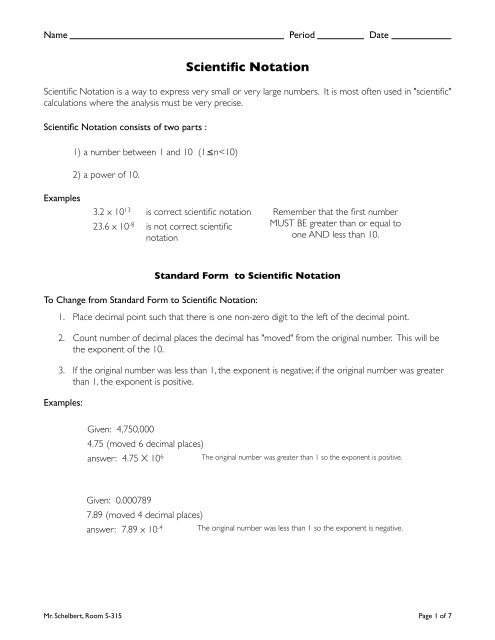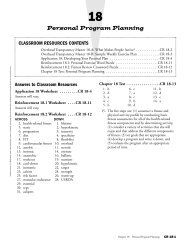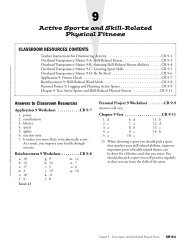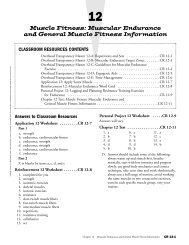SI Units handout - ETHS
SI Units handout - ETHS
SI Units handout - ETHS
Create successful ePaper yourself
Turn your PDF publications into a flip-book with our unique Google optimized e-Paper software.
Name Period Date<br />
Scientific Notation<br />
Scientific Notation is a way to express very small or very large numbers. It is most often used in "scientific"<br />
calculations where the analysis must be very precise.<br />
Scientific Notation consists of two parts :<br />
Examples<br />
1) a number between 1 and 10 (1≤n
Name Period Date<br />
Scientific Notation to Standard Form<br />
To Change from Scientific Notation to Standard Form:<br />
1. Move decimal point to right for positive exponent of 10.<br />
2. Move decimal point to left for negative exponent of 10.<br />
Examples:<br />
Given: 1.015 x 10-8 Given: 1.015 x 10-8 answer: 0.00000001015 (8 places to left)<br />
Given: 5.024 x 103 Given: 5.024 x 103 Negative exponent move decimal to the left.<br />
answer: 5,024 (3 places to right) Positive exponent move decimal to the right.<br />
To Multiply and/or Divide using Scientific Notation:<br />
1. Multiply/divide decimal numbers with each other.<br />
2. Use exponent rules to "combine" powers of 10.<br />
3. If not "correct" scientific notation, change accordingly.<br />
Example:<br />
Given:<br />
(5.29x10 6 )(1.17x10 -4 )<br />
2.35x10 -2 Solution: 1)<br />
2)<br />
(5.29)(1.17)<br />
=2.6337<br />
2.35<br />
(10 6 )(10 -4 )<br />
10 -2 =10 6-4-(-2) =10 4<br />
3) 2.6337x10 4 or 2.6x10 4<br />
Mr. Schelbert, Room S-315 Page 2 of 7
Name Period Date<br />
<strong>SI</strong> <strong>Units</strong> Tables<br />
<strong>SI</strong> Base <strong>Units</strong><br />
Base Quantity Base Unit Symbol<br />
Length meter m<br />
Mass kilogram kg<br />
Time second s<br />
Temperature kelvin K<br />
Amount of a substance mole mol<br />
Electric Current ampere A<br />
Luminous intensity candela cd<br />
Prefixes Used with <strong>SI</strong> <strong>Units</strong><br />
Prefix Symbol Multiplier Scientific Notation Example<br />
femto- f 0.000000000000001 10 -15 femtosecond (fs)<br />
pico- p 0.000000000001 10 -12 picometer (pm)<br />
nano- n 0.000000001 10 --9 nanometer (nm)<br />
micro- µ 0.000001 10 --6 microgram (µg)<br />
milli- m 0.001 10 -3 milliamp (mA)<br />
centi- c 0.01 10 -2 centimeter (cm)<br />
deci- d 0.1 10 -1 deciliter (dL)<br />
kilo- k 1000 10 3 kilometer (km)<br />
mega- M 1,000,000 10 6 megagram (Mg)<br />
giga- G 1,000,000,000 10 9 gigameter (Gm)<br />
tera- T 1,000,000,000,000 10 12 terahertz (THz)<br />
Mr. Schelbert, Room S-315 Page 3 of 7
Name Period Date<br />
Make the following conversions:<br />
Scientific Notation and Unit Prefixes<br />
1) 3.4 liters to milliliters 6) 45 meters to centimeters<br />
2) 876 millimeters to meters 7) 11.7 grams to kilograms<br />
3) 78,999 milligrams to grams 8) 0.0009 kiloliters to liters<br />
4) 0.9 centigrams to grams 9) 44 centimeters to meters<br />
5) 112 meters to millimeters 10) 277 kilograms to grams<br />
Convert the following to scientific notation:<br />
11) 45,700 ______________________________<br />
12) 0.009 ______________________________<br />
13) 23 ______________________________<br />
14) 0.9 ______________________________<br />
15) 24,212,000 ______________________________<br />
16) 0.000665 ______________________________<br />
Mr. Schelbert, Room S-315 Page 4 of 7
Name Period Date<br />
Convert the following to scientific notation:<br />
17) 21.9 ______________________________<br />
18) 0.00332 ______________________________<br />
19) 321 ______________________________<br />
20) 0.119 ______________________________<br />
21) 1492 ______________________________<br />
22) 0.2713 ______________________________<br />
23) 314159 ______________________________<br />
24) 6022 ______________________________<br />
25) 0.12011 ______________________________<br />
Convert the following numbers in scientific notation to expanded form:<br />
26) 3.825 x 103 ______________________________<br />
27) 6.3 x 10 4 ______________________________<br />
28) 2.3 x 10 -2 ______________________________<br />
29) 4.44 x 10 -6 ______________________________<br />
30) 7.121 x 10 9 ______________________________<br />
31) 1.2 x 10 -1 ______________________________<br />
32) 1.8 x 10 2 ______________________________<br />
33) 8.1 x 10 -4 ______________________________<br />
34) 6.7 x 10 5 ______________________________<br />
35) 3.4 x 10 7 ______________________________<br />
Mr. Schelbert, Room S-315 Page 5 of 7
Name Period Date<br />
Using <strong>SI</strong> <strong>Units</strong><br />
Match the terms in Column II with the descriptions in Column I. Write the letters of the correct term in<br />
the blank on the left.<br />
Column I Column II<br />
_____ 1. distance between two points a. time<br />
_____ 2. <strong>SI</strong> unit of length b. volume<br />
_____ 3. tool used to measure length c. mass<br />
_____ 4. units obtained by combining other units d. density<br />
_____ 5. amount of space occupied by an object e. meter<br />
_____ 6. unit used to express volume f. kilogram<br />
_____ 7. <strong>SI</strong> unit of mass g. derived<br />
_____ 8. amount of matter in an object h. liter<br />
_____ 9. mass per unit of volume i. second<br />
_____ 10. temperature scale of most laboratory thermometers j. Kelvin<br />
_____ 11. instrument used to measure mass k. length<br />
_____ 12. interval between two events 1. balance<br />
_____ 13. <strong>SI</strong> unit of temperature m. meterstick<br />
_____ 14. <strong>SI</strong> unit of time n. thermometer<br />
_____ 15. instrument used to measure temperature o. Celsius<br />
Circle the two terms in each group that are related. Explain how the terms are related.<br />
16. Celsius degree, mass, Kelvin<br />
17. balance, second, mass<br />
18. kilogram, liter, cubic centimeter<br />
19. time, second, distance<br />
20. decimeter, kilometer, Kelvin<br />
Mr. Schelbert, Room S-315 Page 6 of 7
Name Period Date<br />
Standards of Measurement<br />
Some prefixes used in <strong>SI</strong> are listed in the table below. Use the information in the table to<br />
answer questions 1—5.<br />
<strong>SI</strong> Prefix Meaning<br />
kilo- thousand (1000)<br />
Hecto- Hundred (100)<br />
Deka- Ten (10)<br />
Deci- Tenth (0.10)<br />
Centi- Hundredth (0.01)<br />
Milli- Thousandth (0.001)<br />
1. How many meters are in one kilometer? __________<br />
2. What part of a liter is one milliliter? __________<br />
3. How many grams are in two dekagrams? __________<br />
4. If one gram of water has a volume of one milliliter, what would the mass of one liter of water be in<br />
kilograms?__________<br />
5. What part of a meter is a decimeter? __________<br />
In the blanks for questions 6 through 11, write the term that correctly completes each statement.<br />
Choose from the terms listed below.<br />
Metric <strong>SI</strong> standard<br />
ten prefixes tenth<br />
6. An exact quantity that people agree to use for comparison is a ______________ .<br />
7. The system of measurement used worldwide in science is _______________ .<br />
8. <strong>SI</strong> is based on units of _______________ .<br />
9. The first system of measurement that was based on units of ten was the _______________ system.<br />
10. In <strong>SI</strong>, _______________ are used with the names of the base unit to indicate the multiple of ten that is<br />
being used with the base unit.<br />
11. The prefix deci- means _______________<br />
Mr. Schelbert, Room S-315 Page 7 of 7






